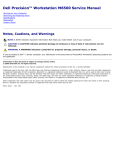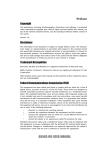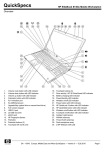Download Dell M4500 Specifications
Transcript
Dell Precision™ Mobile Workstation M4500 Service Manual Working on Your Computer Removing and Replacing Parts Specifications Diagnostics System Setup Notes, Cautions, and Warnings NOTE: A NOTE indicates important information that helps you make better use of your computer. CAUTION: A CAUTION indicates potential damage to hardware or loss of data if instructions are not followed. WARNING: A WARNING indicates a potential for property damage, personal injury, or death. If you purchased a Dell™ n Series computer, any references in this document to Microsoft® Windows® operating systems are not applicable. Information in this document is subject to change without notice. © 2010 Dell Inc. All rights reserved. Reproduction of this material in any manner whatsoever without the written permission of Dell Inc. is strictly forbidden. Trademarks used in this text: Dell, the DELL logo, Latitude ON, Precision, and Wi-Fi Catcher are trademarks of Dell Inc.; Intel, SpeedStep, TurboBoost, a n d Core are either trademarks or registered trademarks of Intel Corporation; Bluetooth is a registered trademark owned by Bluetooth SIG, Inc. and is used by Dell under license; Blu-ray Disc is a trademark of the Blu-ray Disc Association; Microsoft, Windows, Windows Vista, and the Windows Vista start button are either trademarks or registered trademarks of Microsoft Corporation in the United States and/or other countries; Adobe, the Adobe logo, and Adobe Flash Player are trademarks of Adobe Systems Incorporated. Other trademarks and trade names may be used in this document to refer to either the entities claiming the marks and names or their products. Dell Inc. disclaims any proprietary interest in trademarks and trade names other than its own. June 2010 Rev. A00 Back to Contents Page Access Panel Dell Precision™ Mobile Workstation M4500 Service Manual WARNING: Before working inside your computer, read the safety information that shipped with your computer. For additional safety best practices information, see the Regulatory Compliance Homepage at www.dell.com/regulatory_compliance. Removing the Access Panel NOTE: You may need to install Adobe™ Flash Player™ from Adobe.com in order to view the illustrations below. 1. 2. Follow the procedures in Before Working Inside Your Computer. Loosen the captive screw that secures the access panel to the base of the computer. 3. Slide the access panel towards the front of the computer. 4. Lift the access panel up and away from the computer. Replacing the Access Panel To replace the access panel, perform the above steps in reverse order. Back to Contents Page Back to Contents Page Battery Dell Precision™ Mobile Workstation M4500 Service Manual WARNING: Before working inside your computer, read the safety information that shipped with your computer. For additional safety best practices information, see the Regulatory Compliance Homepage at www.dell.com/regulatory_compliance. Removing the Battery NOTE: You may need to install Adobe™ Flash Player™ from Adobe.com in order to view the illustrations below. 1. 2. Follow the procedures in Before Working Inside Your Computer. Slide the battery release latches to the unlock position. 3. Slide and remove the battery from the computer. Replacing the Battery To replace the battery, perform the above steps in reverse order. Back to Contents Page Back to Contents Page Bottom Chassis Assembly Dell Precision™ Mobile Workstation M4500 Service Manual WARNING: Before working inside your computer, read the safety information that shipped with your computer. For additional safety best practices information, see the Regulatory Compliance Homepage at www.dell.com/regulatory_compliance. Removing the Bottom Chassis Assembly NOTE: You may need to install Adobe™ Flash Player™ from Adobe.com in order to view the illustrations below. 1. 2. 3. 4. 5. 6. 7. 8. 9. 10. 11. 12. 13. 14. 15. 16. 17. 18. 19. 20. Follow the procedures in Before Working Inside Your Computer. Remove the battery. Remove the access panel. Remove the subscriber identity module (SIM) card. Remove the optical drive. Remove the keyboard. Remove the coin-cell battery. Remove the hinge covers. Remove the display Assembly. Remove the hard drive. Remove the Latitude ON™ Flash card. Remove the wireless wide area network (WWAN) card. Remove the wireless local area network (WLAN) card. Remove the heat sink and fan assembly. Remove the Processor. Remove the palm rest assembly. Remove the Bluetooth® card. Remove the Express Card Board. Remove the SD Media Board. Remove the I/O Port Card. Replacing the Bottom Chassis Assembly To replace the bottom chassis assembly, perform the above steps in reverse order. Back to Contents Page Back to Contents Page System Setup Dell Precision™ Mobile Workstation M4500 Service Manual Overview Entering System Setup Boot Menu Navigation Keystrokes System Setup Menu Options Overview Use System Setup as follows: l To change the system configuration information after you add, change, or remove any hardware in your computer l To set or change a user-selectable option such as the user password l To read the current amount of memory or set the type of hard drive installed Before you use System Setup, it is recommended that you write down the System Setup screen information for future reference. CAUTION: Unless you are an expert computer user, do not change the settings for this program. Certain changes can cause your computer to work incorrectly. Entering System Setup 1. 2. Turn on (or restart) your computer. When the blue DELL™ logo is displayed, press <F2> immediately. Boot Menu The Boot menu lists all the valid boot devices for your computer. Use the Boot menu to: l l l Run diagnostics on your computer Enter system setup Change the boot sequence without changing the boot sequence permanently in the system setup. To access the Boot menu: 1. 2. Turn on (or restart) your computer. When the blue DELL™ logo is displayed, press <F12> immediately. Navigation Keystrokes Use the following keystrokes to navigate System Setup screens. Navigation Action Keystroke(s) Expand and collapse field <Enter>, left- or right-arrow key, or +/– Expand or collapse all fields <> Exit BIOS <Esc>—Remain in Setup, Save/Exit, Discard/Exit Change a setting Left or right-arrow key Select field to change <Enter> Cancel modification <Esc> Reset defaults <Alt><F> or Load Defaults menu option System Setup Menu Options The following tables describe the menu options for the System Setup program. General Option Description This section lists the primary hardware features of your computer. There are no configurable options in this section. l l System Information ¡ BIOS Version ¡ Service Tag ¡ Asset Tag ¡ Ownership Tag Memory Information Memory Installed Memory Available Memory Speed ¡ Memory Channel Mode ¡ Memory Technology ¡ DIMM A Size ¡ DIMM B Size Processor Information ¡ Processor Type ¡ Core Count ¡ Processor ID ¡ Current Clock Speed Device Information ¡ Primary Hard Drive ¡ System eSATA Device ¡ Dock eSATA Device ¡ Video Controller ¡ Video BIOS Version ¡ Video Memory ¡ Panel Type ¡ Native Resolution ¡ Audio Controller ¡ Modem Controller ¡ Wi-Fi Device ¡ Cellular Device ¡ Bluetooth Device ¡ ¡ ¡ l System Information l Battery Information Displays the status of the battery and the type of AC adapter connected to the computer. Specifies the order in which the computer attempts to find an operating system. l l l Boot Sequence l l l l Date/Time Cardbus NIC Diskette drive USB Storage Device Internal HDD CD/DVD/CD-RW Drive Built-in EFI shell Onboard NIC Displays current date and time settings. NOTE: System Configuration contains options and settings related to integrated system devices. Depending on your computer and installed devices, the items listed in this section may or may not appear. Default setting: All enabled. System Configuration Option Description Integrated NIC Allows you to configure the integrated network controller. The options are: Disabled, Enabled, and Enabled w/PXE. Parallel Port Allows you to enable or disable the parallel ports on the docking station. The options are: Disabled, AT, PS2, and ECP. Serial Port Allows you to avoid resource conflicts between devices by disabling or remapping the address of the port. The options are: Disabled, COM1, COM2, COM3, and COM4. SATA Operation Allows you to configure the operating mode of the internal SATA hard drive controller. The options are: Disabled, ATA, and AHCI Allows you to enable or disable the following devices: l l Miscellaneous Devices l l l l l l USB PowerShare Internal Modem Module Bay Express Card Hard Drive Free Fall Protection External USB Port Microphone eSATA Ports Media Card, PC Card and 1394 Allows you to charge external devices using the stored system battery power through the USB PowerShare port on the notebook, even while the notebook is turned off. Video Option Description Ambient Light Sensor Allows your system to automatically change the brightness of your system's LCD panel based on the amount of light in the environment. LCD Brightness Allows you to set the display brightness depending up on the power source (On Battery and On AC). Security Option Description Allows you to set, change, or delete the administrator (admin) password. When set, the admin password enables several security features including: l l Admin Password l l Restricts changes to the settings in Setup Restricts the boot devices listed in the <F12> Boot Menu to those enabled in the "Boot Sequence" field Prohibits changes to the owner and asset tags Substitutes for the system and hard drive password NOTE: You must set the admin password before you set the system or hard drive password. NOTE: Successful password changes take effect immediately. NOTE: Deleting the admin password automatically deletes the system password as well. System Password Allows you to set, change, or delete the system password. When set, your computer requests you to enter the system password every time your computer turns on or restarts. NOTE: Successful password changes take effect immediately. Internal HDD Password This field lets you set, change, or delete the password on the system's internal hard disk drive (HDD). Successful changes take place immediately and require a system restart. The HDD password travels with the hard drive, so the HDD is protected even when installed in another system. Allows you to bypass the system and internal hard drive password prompts when your computer restarts or resumes from standby. Password Bypass You can set Password Bypass to: Disabled, Reboot Bypass, Resume Bypass, and Reboot & Resume Bypass. NOTE: You cannot bypass the system or hard drive password when you turn on your computer that has been shut down. Password Change Allows you to enable of disable changes to the System and hard drive passwords when the admin password is set. Allows you to enable or disable the Trusted Platform Module (TPM) on the computer. NOTE: Disabling this option does not change any settings you may have made to the TPM, or delete any information or keys you may have stored there. TPM Security When TPM is enabled, the following options are available: l l l Deactivate—Disables the TPM. The TPM restricts access to the stored owner information and does not execute any commands that use TPM resources. Activate—Enables and activates the TPM. Clear—Clears the owner information stored in the TPM. Allows you to enable or disable the optional Computrace software. The options are Deactivate, Disable, and Activate. Computrace® NOTE: The Activate and Disable options will permanently activate or disable the feature and no further changes will be allowed. Allows you to enable or disable the Execute Disable mode of the processor. CPU XD Support Default setting: Enabled Determine whether changes to the setup option are permitted when an administrator password is set. If disabled the setup option is locked by the admin password. It cannot be modified unless setup is unlocked. Setup is unlocked when there is no admin password, or Non-Admin Setup when the admin password has been entered. When enabled, the device setting can be modified even when other setup options are locked by the admin password. Changes Default setting: Disabled Performance Option Description Multi Core Support Enables or disables multi-core support for the processor. HDD Acoustic Mode Allows you to optimize the performance and acoustic noise level of the hard drive. Intel® SpeedStep™ Enables or disables the Intel SpeedStep feature. Intel® TurboBoost™ Enables or disables the Intel TurboBoost feature. Power Management Option Description Wake on AC Allows you to enable or disable the computer from turning on automatically when an AC adapter is connected. Allows you to set the time at which the computer must turn on automatically. Auto On Time You can set the of days, if any, when you would like the system to turn on automatically. The settings are Disabled, Everyday, or Weekdays. Default setting: Off Allows you to enable or disable the ability of USB devices to wake the computer from Standby. USB Wake Support This feature is only functional when the AC power adapter is connected. If the AC power adapter is removed during Standby, the BIOS will remove power from all of the USB ports to conserve battery power. Allows the computer to turn on by a special LAN signal or from Hibernate state when triggered by a special wireless LAN signal. Wake-up from the Standby state is unaffected by this setting and must be enabled in the operating system. Wake on LAN l l Disabled — Do not allow the system to power on when it receives a wake-up signal from the LAN or wireless LAN. LAN Only — Allow the system to be powered on by special LAN signals. The factory default setting is Disabled. Allows you to enable or disable the ExpressCharge feature. ExpressCharge NOTE: ExpressCharge may not be available for all battries. Charger Behavior Allows you to enable or disable the battery charger. If disabled, the battery will not lose power when the system is connected to an AC adapter but it will not charge either. Default setting: Enabled POST Behavior Option Description Adapter Warnings Allows you to enable or disable the BIOS warning messages when you use certain power adapters. The BIOS displays these messages if you attempt to use a power adapter that has too little capacity for your configuration. The factory default setting is Enabled. Allows you to select one of two methods to enable the keypad that is embedded in the internal keyboard. l l Keypad (Embedded) Fn Key Only — The keypad is only enabled when you hold down the <Fn> key. By Num Lk — The keypad is enabled when (1) the Num Lock LED is on and (2) no external keyboard is attached. Note that the system might not notice immediately when an external keyboard is detached. NOTE: When Setup is running, this field has no effect—Setup works in the Fn Key Only mode. Default setting: Fn Key Only. Determines how the system handles mouse and the touchpad input. Mouse/Touchpad Default setting: Touchpad/PS-2 Mouse. Allows you to enable or disable the Num Lock LED when the computer boots. Numlock LED Default setting: Enabled. Defines how the BIOS handles the USB devices. USB emulation is always enabled during POST. USB Emulation The factory default setting is Enabled. Allows you to use the <Scroll Lock> key on an external PS/2 keyboard the same way you use the <Fn> key on the computer's internal keyboard. Fn Key Emulation NOTE: USB keyboards cannot emulate the <Fn> key if you are running an ACPI operating system such as Microsoft® Windows® XP. USB keyboards will only emulate the <Fn> key in non-ACPI mode (e.g., when you are running a DOS). Default setting: Enabled. Allows you to enable or disable the Fast Boot feature. The following options are available: l l Fast Boot l Minimal — Boot quickly unless the BIOS has been updated, memory changed, or the previous POST did not complete. Thorough — Do not skip any steps in the boot process. Auto — Allow the operating system to control this setting (this works only when the operating system supports Simple Boot Flag). Default setting: Minimal Intel Fast Call for Help Used in conjunction with iAMT 4.0. Allows you to initiate contact with a management console while residing outside of the corporate infrastructure (i.e. remote location, behind a firewall or NAT, etc.) Use the check box to enable / disable this feature. Default setting: Disabled Virtualization Support Option Description Vitualization Specifies whether a Virtual Machine Monitor (VMM) can utilize the additional hardware capabilities provided by Intel Virtualization Technology. Default setting: Enabled. VT for Direct I/O Specifies whether a Virtual Machine Monitor (VMM) can utilize the additional hardware capabilities provided by Intel Virtualization Technology for Direct I/O. Default setting: Disabled. Specifies whether a Measured Virtual Machine Monitor(MVMM) can utilize the additional hardware capabilities provided by Intel Trusted Execution Technology. Trusted Execution Default setting: Disabled. Wireless Option Description Wireless Switch Allows you to choose the wireless devices that can be controlled by the wireless switch. Wireless Devices Enable Allows you to enable or disable the following internal wireless devices: WWAN, WLAN, and Bluetooth. Maintenance Option Description Displays your computer's Service Tag. If for some reason the Service Tag was not already set, you would be able to use this field to set it. Service Tag Asset Tag If a Service Tag has not been set for this computer, the computer will automatically bring up this screen when you enter the BIOS. You will be prompted to enter the Service Tag. Allows you to create a system Asset Tag. The field can only be updated if the Asset Tag is not already set. System Logs Option Description BIOS Events Allows you to view and clear BIOS POST events. It includes the date and time of the event as well as the LED code. DellDiag Events Allows you to view the diagnostic results from Dell Diagnostics and PSA. It includes the time and date, the diagnostic and version which was run and the resulting code. Thermal Events Allows you to view and clear thermal events. It includes the date and time as well as the name of the event. Power Events Allows you to view and clear power events. It includes the date and time of the event as well as the power state and reason. BIOS Progress Events Allows you to view and clear BIOS Progress events. It includes the date and time of the event as well as the power state. Back to Contents Page Back to Contents Page Bluetooth Card Dell Precision™ Mobile Workstation M4500 Service Manual WARNING: Before working inside your computer, read the safety information that shipped with your computer. For additional safety best practices information, see the Regulatory Compliance Homepage at www.dell.com/regulatory_compliance. Removing the Bluetooth Card NOTE: You may need to install Adobe™ Flash Player™ from Adobe.com in order to view the illustrations below. 1. 2. 3. 4. 5. 6. 7. 8. 9. Follow the procedures in Before Working Inside Your Computer. Remove the battery. Remove the access panel. Remove the optical drive. Remove the keyboard. Remove the hinge covers. Remove the palm rest assembly. Remove the display assembly. Remove the screw that secures the Bluetooth® card to the system board. 10. Disconnect the Bluetooth cable from its connector on the system board and remove the Bluetooth card from the computer. 11. Disconnect the Bluetooth cable from the Bluetooth card. Replacing the Bluetooth Card To replace the Bluetooth card, perform the above steps in reverse order. Back to Contents Page Back to Contents Page Camera and Microphone Dell Precision™ Mobile Workstation M4500 Service Manual WARNING: Before working inside your computer, read the safety information that shipped with your computer. For additional safety best practices information, see the Regulatory Compliance Homepage at www.dell.com/regulatory_compliance. Removing the Camera and Microphone NOTE: You may need to install Adobe™ Flash Player™ from Adobe.com in order to view the illustrations below. 1. 2. 3. 4. 5. 6. 7. Follow the procedures in Before Working Inside Your Computer. Remove the battery. Remove the access panel. Remove the hinge covers. Remove the display assembly. Remove the display bezel. Loosen the captive screw that secures the camera and microphone to the display panel. 8. Disconnect the data cable from the camera and microphone and remove lift the camera and microphone up and away from the display panel. Replacing the Camera and Microphone To replace the camera and microphone, perform the above steps in reverse order. Back to Contents Page Back to Contents Page Coin-Cell Battery Dell Precision™ Mobile Workstation M4500 Service Manual WARNING: Before working inside your computer, read the safety information that shipped with your computer. For additional safety best practices information, see the Regulatory Compliance Homepage at www.dell.com/regulatory_compliance. Removing the Coin-Cell Battery NOTE: You may need to install Adobe™ Flash Player™ from Adobe.com in order to view the illustrations below. 1. 2. 3. 4. Follow the procedures in Before Working Inside Your Computer. Remove the battery. Remove the access panel. Disconnect the coin-cell battery cable from its connector on the system board. 5. Lift the coin-cell battery up and away from the computer. Replacing the Coin-Cell Battery To replace the coin-cell battery, perform the above steps in reverse order. Back to Contents Page Back to Contents Page DC-In Port Dell Precision™ Mobile Workstation M4500 Service Manual WARNING: Before working inside your computer, read the safety information that shipped with your computer. For additional safety best practices information, see the Regulatory Compliance Homepage at www.dell.com/regulatory_compliance. Removing the DC-In Port NOTE: You may need to install Adobe™ Flash Player™ from Adobe.com in order to view the illustrations below. 1. 2. 3. 4. 5. 6. 7. 8. 9. 10. 11. 12. 13. 14. 15. 16. 17. 18. 19. 20. 21. 22. Follow the procedures in Before Working Inside Your Computer. Remove the battery. Remove the access panel. Remove the subscriber identity module (SIM) card. Remove the optical drive. Remove the keyboard. Remove the coin-cell battery. Remove the hinge covers. Remove the display assembly. Remove the hard drive. Remove the Latitude ON™ Flash card. Remove the wireless wide area network (WWAN) card. Remove the wireless local area network (WLAN) card. Remove the heat sink and fan assembly. Remove the processor. Remove the palm rest assembly. Remove the Bluetooth® card. Remove the ExpressCard board. Remove the SD card board. Remove the system board. Remove the I/O port card. Release the DC-in port from its routing guides on the chassis. 23. Lift the DC-In port up and remove it from the chassis. Replacing the DC-In Port To replace the DC-In port, perform the above steps in reverse order. Back to Contents Page Back to Contents Page Diagnostics Dell Precision™ Mobile Workstation M4500 Service Manual Device Status Lights Battery Status Lights Battery Charge and Health Keyboard Status Lights LED Error Codes Device Status Lights Turns on when you turn on the computer and blinks when the computer is in a power management mode. Turns on when the computer reads or writes data. Turns on steadily or blinks to indicate battery charge status. Turns on when wireless networking is enabled. Turns on when a card with Bluetooth® wireless technology is enabled. To turn off only the Bluetooth wireless technology function, right-click the icon in the system tray and select Disable Bluetooth Radio. Battery Status Lights If the computer is connected to an electrical outlet, the battery light operates as follows: l l l l l Alternately blinking amber light and blue light — An unauthenticated or unsupported, non-Dell AC adapter is attached to your laptop. Alternately blinking amber light with steady blue light — Temporary battery failure with AC adapter present. Constantly blinking amber light — Fatal battery failure with AC adapter present. Light off — Battery in full charge mode with AC adapter present. Blue light on — Battery in charge mode with AC adapter present. Battery Charge and Health To check the battery charge, press and release the status button on the battery charge gauge to illuminate the charge-level lights. Each light represents approximately 20 percent of the total battery charge. For example, if four lights are on, the battery has 80 percent of its charge remaining. If no lights appear, the battery has no charge. To check battery health using the charge gauge, press and hold the status button on the battery charge gauge for at least 3 seconds. If no lights appear, the battery is in good condition and more than 80 percent of its original charge capacity remains. Each light represents incremental degradation. If five lights appear, less than 60 percent of the charge capacity remains, and you should consider replacing the battery. Keyboard Status Lights The green lights located above the keyboard indicate the following: Turns on when the numeric keypad is enabled. Turns on when the Caps Lock function is enabled. Turns on when the Scroll Lock function is enabled. LED Error Codes The following table shows the possible LED codes that may display in a no-POST situation. Appearance Description ON-FLASH-FLASH Next Step 1. 2. No SODIMMs are installed 4. Install supported memory modules. If memory is already present, reseat the module(s) one at time in each slot. Try known good memory from another computer or replace the memory. Replace the system board. 1. 2. 3. Reseat the processor. Replace the system board. Replace the processor. 3. FLASH-ON-ON System board error FLASH-ON-FLASH Display panel error OFF-FLASH-OFF 1. 2. 3. Reseat the display cable. Replace the display panel. Replace the video card/system board. 1. 2. Install compatible memory modules. If two modules are installed remove one and test. Try the other module in the same slot and test. Test the other slot with both modules. Replace the memory. Replace the system board. Memory compatibility error 3. 4. ON-FLASH-ON 1. 2. Memory is detected but has errors 3. 4. Reseat the memory. If two modules are installed remove one and test. Try the other module in the same slot and test. Test the other slot with both modules. Replace the memory. Replace the system board. 1. 2. 3. Reseat the modem. Replace the modem. Replace the system board. 1. Replace the system board. 1. 2. 3. Reseat the device. Replace the device. Replace the system board. 1. 2. Reseat the hard drive and optical drive. Test the computer with just the hard drive and just the optical drive. Replace the device that is causing the failure. Replace the system board. OFF-FLASH-FLASH Modem error FLASH-FLASH-FLASH System board error FLASH-FLASH-OFF Option ROM error OFF-ON-OFF Storage device error 3. 4. FLASH-FLASH-ON Video card error Back to Contents Page Replace the system board. Back to Contents Page ExpressCard Board Dell Precision™ Mobile Workstation M4500 Service Manual WARNING: Before working inside your computer, read the safety information that shipped with your computer. For additional safety best practices information, see the Regulatory Compliance Homepage at www.dell.com/regulatory_compliance. Removing the ExpressCard Board NOTE: You may need to install Adobe Flash Player from Adobe.com in order to view the illustrations below. 1. 2. 3. 4. 5. 6. 7. 8. 9. 10. Follow the procedures in Before Working Inside Your Computer. Remove the battery. Remove the ExpressCard. Remove the access panel. Remove the optical drive. Remove the keyboard. Remove the hinge covers. Remove the display assembly. Remove the palm rest assembly. Remove the screws that secure the ExpressCard board to the system board. 11. Disconnect the ExpressCard board from the system board and remove it from the computer. Replacing the ExpressCard Board To replace the ExpressCard board, perform the above steps in reverse order. Back to Contents Page Back to Contents Page ExpressCard Dell Precision™ Mobile Workstation M4500 Service Manual WARNING: Before working inside your computer, read the safety information that shipped with your computer. For additional safety best practices information, see the Regulatory Compliance Homepage at www.dell.com/regulatory_compliance. Removing the ExpressCard NOTE: You may need to install Adobe™ Flash Player™ from Adobe.com in order to view the illustrations below. 1. Press on the ExpressCard and release it from the computer. 2. Slide the ExpressCard out of the computer. Replacing the ExpressCard To replace the ExpressCard, perform the above steps in reverse order. Back to Contents Page Back to Contents Page Fingerprint Reader Dell Precision™ Mobile Workstation M4500 Service Manual WARNING: Before working inside your computer, read the safety information that shipped with your computer. For additional safety best practices information, see the Regulatory Compliance Homepage at www.dell.com/regulatory_compliance. Removing the Fingerprint Reader NOTE: You may need to install Adobe™ Flash Player™ from Adobe.com in order to view the illustrations below. 1. 2. 3. 4. 5. 6. Follow the procedures in Before Working Inside Your Computer. Remove the battery. Remove the access panel. Remove the optical drive. Remove the keyboard. Loosen the captive screw (labeled 'F') that secures the fingerprint reader to the computer. 7. Open the clip that secures the fingerprint data cable and disconnect it from the system board. 8. Push the fingerprint reader from the back of the computer to remove the fingerprint reader from the computer. Replacing the Fingerprint Reader To replace the fingerprint reader, perform the above steps in reverse order. Back to Contents Page Back to Contents Page Hard Drive Dell Precision™ Mobile Workstation M4500 Service Manual WARNING: Before working inside your computer, read the safety information that shipped with your computer. For additional safety best practices information, see the Regulatory Compliance Homepage at www.dell.com/regulatory_compliance. Removing the Hard Drive NOTE: You may need to install Adobe™ Flash Player™ from Adobe.com in order to view the illustrations below. 1. 2. 3. Follow the procedures in Before Working Inside Your Computer. Place the computer upside down on a clean, flat surface. Remove the screws that secure the hard drive to the computer. 4. Slide the hard drive out of the computer. 5. Remove the screw that secures the face plate to the hard drive. 6. Pull out the face plate to remove it from the hard drive. Replacing the Hard Drive To replace the hard drive, perform the above steps in reverse order. Back to Contents Page Back to Contents Page Heat Sink and Fan Assembly Dell Precision™ Mobile Workstation M4500 Service Manual WARNING: Before working inside your computer, read the safety information that shipped with your computer. For additional safety best practices information, see the Regulatory Compliance Homepage at www.dell.com/regulatory_compliance. Removing the Heat Sink and Fan Assembly NOTE: You may need to install Adobe™ Flash Player™ from Adobe.com in order to view the illustrations below. 1. 2. 3. 4. Follow the procedures in Before Working Inside Your Computer. Remove the battery. Remove the access panel. Disconnect the cable that connects the fan to the system board. 5. Loosen the captive screws that secure the heat sink to the system board. 6. Lift the edge of the heat sink that is closest to the center of the computer, and then slide the heat sink and fan assembly out of the computer. 7. Remove the screws that secure the fan to the heat sink. 8. Remove the fan from the heat sink. Replacing the Heat Sink and Fan Assembly To replace the heat sink and fan assembly, perform the above steps in reverse order. Back to Contents Page Back to Contents Page I/O Board Dell Precision™ Mobile Workstation M4500 Service Manual WARNING: Before working inside your computer, read the safety information that shipped with your computer. For additional safety best practices information, see the Regulatory Compliance Homepage at www.dell.com/regulatory_compliance. Removing the I/O Board NOTE: You may need to install Adobe™ Flash Player™ from Adobe.com in order to view the illustrations below. 1. 2. 3. 4. 5. 6. 7. 8. 9. 10. 11. 12. 13. 14. 15. 16. 17. 18. 19. 20. Follow the procedures in Before Working Inside Your Computer. Remove the battery. Remove the access panel. Remove the subscriber identity module (SIM) card. Remove the optical drive. Remove the keyboard. Remove the coin-cell battery. Remove the hinge covers. Remove the display assembly. Remove the hard drive. Remove the Latitude ON™ flash card. Remove the wireless wide area network (WWAN) card. Remove the wireless local area network (WLAN) card. Remove the heat sink and fan assembly. Remove the processor. Remove the palm rest assembly. Remove the Bluetooth® card. Remove the ExpressCard board. Remove the system board. Remove the screw (labeled 'I') that secures the I/O board to the computer. 21. Remove the screws that secure the I/O board to the computer. 22. Remove the I/O board from the computer. Replacing the I/O Board To replace the I/O board, perform the above steps in reverse order. Back to Contents Page Back to Contents Page Keyboard Dell Precision™ Mobile Workstation M4500 Service Manual WARNING: Before working inside your computer, read the safety information that shipped with your computer. For additional safety best practices information, see the Regulatory Compliance Homepage at www.dell.com/regulatory_compliance. Removing the Keyboard NOTE: You may need to install Adobe Flash Player from Adobe.com in order to view the illustrations below. 1. 2. 3. 4. Follow the procedures in Before Working Inside Your Computer. Remove the battery. Remove the LED cover. Remove the screws along the top of the keyboard. 5. Using the pull tab, gently lift the keyboard at an angle and slide it out of the computer. Replacing the Keyboard To replace the keyboard, perform the above steps in reverse order. Back to Contents Page Back to Contents Page Latitude ON Flash Card Dell Precision™ Mobile Workstation M4500 Service Manual WARNING: Before working inside your computer, read the safety information that shipped with your computer. For additional safety best practices information, see the Regulatory Compliance Homepage at www.dell.com/regulatory_compliance. Removing the Latitude ON Flash Card NOTE: You may need to install Adobe™ Flash Player™ from Adobe.com in order to view the illustrations below. 1. 2. 3. 4. Follow the procedures in Before Working Inside Your Computer. Remove the battery. Remove the access panel. Remove the screw that secures the Latitude ON™ Flash card to the system board. 5. Slide the Latitude ON Flash card out of its connector on the system board. Replacing the Latitude ON Flash Card To replace the Latitude ON Flash card, perform the above steps in reverse order. Back to Contents Page Back to Contents Page Display Assembly Dell Precision™ Mobile Workstation M4500 Service Manual WARNING: Before working inside your computer, read the safety information that shipped with your computer. For additional safety best practices information, see the Regulatory Compliance Homepage at www.dell.com/regulatory_compliance. Removing the Display Assembly NOTE: You may need to install Adobe™ Flash Player™ from Adobe.com in order to view the illustrations below. 1. 2. 3. 4. 5. Follow the procedures in Before Working Inside Your Computer. Remove the battery. Remove the access panel. Remove the hinge covers. Loosen the captive screws that secure the display cable to the system board and disconnect the display cable from its connector on the system board. 6. Disconnect and release the antenna cables from wireless local area network (WLAN) card. 7. Remove the screws that secure the display assembly to the computer. 8. Disconnect and release the antenna cables from wireless wide area network (WWAN) card. 9. Remove the screws that secure the display assembly to the computer. 10. Lift the display assembly up and away from the computer. Replacing the Display Assembly To replace the display assembly, perform the above steps in reverse order. Back to Contents Page Back to Contents Page Display Bezel Dell Precision™ Mobile Workstation M4500 Service Manual WARNING: Before working inside your computer, read the safety information that shipped with your computer. For additional safety best practices information, see the Regulatory Compliance Homepage at www.dell.com/regulatory_compliance. Removing the Display Bezel NOTE: You may need to install Adobe™ Flash Player™ from Adobe.com in order to view the illustrations below. 1. 2. 3. 4. 5. 6. Follow the procedures in Before Working Inside Your Computer. Remove the battery. Remove the access panel. Remove the hinge covers. Remove the display assembly. Starting from the bottom, gently pry the bezel inside out from the display assembly. 7. Remove the bezel from the display assembly. Replacing the Display Bezel To replace the display bezel, perform the above steps in reverse order. Back to Contents Page Back to Contents Page Display Cover Dell Precision™ Mobile Workstation M4500 Service Manual WARNING: Before working inside your computer, read the safety information that shipped with your computer. For additional safety best practices information, see the Regulatory Compliance Homepage at www.dell.com/regulatory_compliance. Removing the Display Cover NOTE: You may need to install Adobe™ Flash Player™ from Adobe.com in order to view the illustrations below. 1. 2. 3. 4. 5. 6. 7. 8. Follow the procedures in Before Working Inside Your Computer. Remove the battery. Remove the access panel. Remove the hinge covers. Remove the display assembly. Remove the display bezel. Remove the display panel. Remove the camera and microphone. Replacing the Display Cover To replace the display cover, perform the above steps in reverse order. Back to Contents Page Back to Contents Page Hinge Covers Dell Precision™ Mobile Workstation M4500 Service Manual WARNING: Before working inside your computer, read the safety information that shipped with your computer. For additional safety best practices information, see the Regulatory Compliance Homepage at www.dell.com/regulatory_compliance. Removing the Hinge Covers NOTE: You may need to install Adobe™ Flash Player™ from Adobe.com in order to view the illustrations below. 1. 2. 3. 4. Follow the procedures in Before Working Inside Your Computer. Remove the battery. Remove the access panel. Remove the screws that secure the right hinge cover to the computer. 5. Remove the screws that secure the left hinge cover to the computer. 6. Slide the left and right hinge covers toward the back of the computer and remove them from the computer. Replacing the Hinge Covers To replace the hinge covers, perform the above steps in reverse order. Back to Contents Page Back to Contents Page Display Hook Dell Precision™ Mobile Workstation M4500 Service Manual WARNING: Before working inside your computer, read the safety information that shipped with your computer. For additional safety best practices information, see the Regulatory Compliance Homepage at www.dell.com/regulatory_compliance. Removing the Display Hook(s) NOTE: You may need to install Adobe™ Flash Player™ from Adobe.com in order to view the illustrations below. 1. 2. 3. 4. Follow the procedures in Before Working Inside Your Computer. Remove the battery. Remove the display bezel Remove the screw that secures the display hook to the display panel.. 5. Remove the display hook from the display panel. 6. Remove the screw that secures the display hook to the display panel. 7. Remove the display hook from the display panel. Replacing the Display Hook To replace the display hook(s), perform the above steps in reverse order. Back to Contents Page Back to Contents Page Display Panel Dell Precision™ Mobile Workstation M4500 Service Manual WARNING: Before working inside your computer, read the safety information that shipped with your computer. For additional safety best practices information, see the Regulatory Compliance Homepage at www.dell.com/regulatory_compliance. Removing the Display Panel NOTE: You may need to install Adobe™ Flash Player™ from Adobe.com in order to view the illustrations below. 1. 2. 3. 4. 5. 6. 7. Follow the procedures in Before Working Inside Your Computer. Remove the battery. Remove the access panel. Remove the hinge covers. Remove the display assembly. Remove the display bezel. Remove the screws that secure the display panel to the display assembly. 8. 9. Lift the display panel and gently lay it on a flat clean surface. Disconnect the display cable from the display panel. 10. Remove the display panel from the display assembly. 11. Remove the screws on either sides of the display panel, to release the display brackets. 12. Remove the display brackets from the display panel. Replacing the Display Panel To replace the display panel, perform the above steps in reverse order. Back to Contents Page Back to Contents Page LED Cover Dell Precision™ Mobile Workstation M4500 Service Manual WARNING: Before working inside your computer, read the safety information that shipped with your computer. For additional safety best practices information, see the Regulatory Compliance Homepage at www.dell.com/regulatory_compliance. Removing the LED Cover NOTE: You may need to install Adobe™ Flash Player™ from Adobe.com in order to view the illustrations below. 1. 2. 3. Follow the procedures in Before Working Inside Your Computer. Remove the battery. Press in on the LED cover release latches in the battery bay. 4. Turn the computer over, with the right side facing up and remove the LED cover from the computer. Replacing the LED Cover To replace the LED cover, perform the above steps in reverse order. Back to Contents Page Back to Contents Page Modem Connector Dell Precision™ Mobile Workstation M4500 Service Manual WARNING: Before working inside your computer, read the safety information that shipped with your computer. For additional safety best practices information, see the Regulatory Compliance Homepage at www.dell.com/regulatory_compliance. Removing the Modem Connector NOTE: You may need to install Adobe™ Flash Player™ from Adobe.com in order to view the illustrations below. 1. 2. 3. 4. 5. 6. 7. 8. 9. 10. 11. 12. 13. 14. 15. 16. 17. 18. 19. 20. 21. 22. Follow the procedures in Before Working Inside Your Computer. Remove the battery. Remove the access panel. Remove the subscriber identity module (SIM) card. Remove the optical drive. Remove the keyboard. Remove the coin-cell battery. Remove the hinge covers. Remove the display assembly. Remove the hard drive. Remove the Latitude ON™ Flash card. Remove the wireless wide area network (WWAN) card. Remove the wireless local area network (WLAN) card. Remove the heat sink and fan assembly. Remove the processor. Remove the palm rest assembly. Remove the Bluetooth® card. Remove the ExpressCard board. Remove the SD card board. Remove the system board. Remove the I/O board. Release the modem cable from its routing guides at the bottom of the computer. 23. Release the modem cable from its routing guides inside the computer. 24. Lift the modem connector up and away from the computer. Replacing the Modem Connector To replace the modem connector, perform the above steps in reverse order. Back to Contents Page Back to Contents Page Modem Port Plug Dell Precision™ Mobile Workstation M4500 Service Manual WARNING: Before working inside your computer, read the safety information that shipped with your computer. For additional safety best practices information, see the Regulatory Compliance Homepage at www.dell.com/regulatory_compliance. Removing the Modem Port Plug NOTE: You may need to install Adobe™ Flash Player™ from Adobe.com in order to view the illustrations below. 1. 2. Follow the procedures in Before Working Inside Your Computer. Insert a paper clip into the release hole and remove the modem port plug from the computer. Replacing the Modem Port Plug To replace the modem port plug, slide the modem port plug back into the modem port. Back to Contents Page Back to Contents Page Memory Dell Precision™ Mobile Workstation M4500 Service Manual WARNING: Before working inside your computer, read the safety information that shipped with your computer. For additional safety best practices information, see the Regulatory Compliance Homepage at www.dell.com/regulatory_compliance. Removing the Memory Module(s) NOTE: You may need to install Adobe™ Flash Player™ from Adobe.com in order to view the illustrations below. 1. 2. 3. 4. Follow the procedures in Before Working Inside Your Computer. Remove the battery. Remove the access panel. Carefully spread apart the securing clips on each end of the memory module connector until the memory module pops up. 5. Remove the memory module from the connector. Replacing the Memory To replace the memory modules(s), perform the above steps in reverse order. Back to Contents Page Back to Contents Page Modem Dell Precision™ Mobile Workstation M4500 Service Manual WARNING: Before working inside your computer, read the safety information that shipped with your computer. For additional safety best practices information, see the Regulatory Compliance Homepage at www.dell.com/regulatory_compliance. Removing the Modem NOTE: You may need to install Adobe™ Flash Player™ from Adobe.com in order to view the illustrations below. 1. 2. 3. 4. Follow the procedures in Before Working Inside Your Computer. Remove the battery. Remove the access panel. Remove the screw that secures the modem to the computer. 5. Using the Mylar tab, gently lift the modem up. 6. Disconnect the modem cable from the modem and remove the modem from the computer. Replacing the Modem To replace the modem, perform the above steps in reverse order. Back to Contents Page Back to Contents Page Optical Drive Dell Precision™ Mobile Workstation M4500 Service Manual WARNING: Before working inside your computer, read the safety information that shipped with your computer. For additional safety best practices information, see the Regulatory Compliance Homepage at www.dell.com/regulatory_compliance. Removing the Optical Drive NOTE: You may need to install Adobe™ Flash Player™ from Adobe.com in order to view the illustrations below. 1. 2. Follow the procedures in Before Working Inside Your Computer. Remove the screw that secures the optical drive to the computer. 3. Press in on the optical drive release latch to release the optical drive from the computer. 4. Slide the optical drive out of the computer. Replacing the Optical Drive To replace the optical drive, perform the above steps in reverse order. Back to Contents Page Back to Contents Page Palm Rest Assembly Dell Precision™ Mobile Workstation M4500 Service Manual WARNING: Before working inside your computer, read the safety information that shipped with your computer. For additional safety best practices information, see the Regulatory Compliance Homepage at www.dell.com/regulatory_compliance. Removing the Palm Rest Assembly NOTE: You may need to install Adobe™ Flash Player™ from Adobe.com in order to view the illustrations below. 1. 2. 3. 4. 5. 6. 7. 8. 9. Follow the procedures in Before Working Inside Your Computer. Remove the battery. Remove the access panel. Remove the optical Drive. Remove the keyboard. Remove the hinge Covers. Remove the fingerprint reader. Remove the display assembly. Remove the screws that secure the palm rest to the bottom of the computer. 10. Remove the screws that secure the palm rest to the computer. 11. Disconnect the Smart Card, speakers, touchpad, and RFID (if applicable) cables from their connectors on the system board. NOTE: If you purchased your computer with a contactless Smart Card reader, you must disconnect the RFID cable. 12. Release the palm rest from the computer: a. Starting from the back of the computer, lift the right side of the palm rest to release it from the computer. b. Gently pull the palm rest forward and flip the palm rest over. 13. Disconnect the HAL sensor cable from the system board. 14. Remove the palm rest from the computer. Replacing the Palm Rest Assembly To replace the palm rest assembly, perform the above steps in reverse order. Back to Contents Page Back to Contents Page Removing and Replacing Parts Dell Precision™ Mobile Workstation M4500 Service Manual Battery Secure Digital (SD) card Subscriber Identity Module (SIM) Card Smart Card ExpressCard PCMCIA Card Optical Drive Hard Drive LED Cover Keyboard Access Panel Memory Fingerprint Reader Hinge Covers Modem Modem Port Plug Coin-Cell Battery Wireless Local Area Network (WLAN) Card Wireless Wide Area Network (WWAN) Card Latitude ON™ Flash Card Heat Sink and Fan Assembly Processor Display Assembly Display Bezel Display Hook Display Panel Camera and Microphone Display Cover Palm Rest Assembly PCMCIA Card Cage Bluetooth® Card System Board ExpressCard Board SD Card Board I/O Board DC-In Power Cable Modem Connector Back to Contents Page Bottom Chassis Assembly Back to Contents Page PCMCIA Card Dell Precision™ Mobile Workstation M4500 Service Manual WARNING: Before working inside your computer, read the safety information that shipped with your computer. For additional safety best practices information, see the Regulatory Compliance Homepage at www.dell.com/regulatory_compliance. Removing the PCMCIA Card NOTE: You may need to install Adobe™ Flash Player™ from Adobe.com in order to view the illustrations below. 1. 2. Follow the procedures in Before Working Inside Your Computer. Press the PCMCIA card eject button in to release the eject button from the computer. 3. Press the PCMCIA card eject button in again to release the PCMCIA card from the computer. 4. Slide the PCMCIA card out of the computer. Replacing the PCMCIA Card To replace the PCMCIA card, perform the above steps in reverse order. Back to Contents Page Back to Contents Page PCMCIA Card Cage Dell Precision™ Mobile Workstation M4500 Service Manual WARNING: Before working inside your computer, read the safety information that shipped with your computer. For additional safety best practices information, see the Regulatory Compliance Homepage at www.dell.com/regulatory_compliance. Removing the PCMCIA Card Cage NOTE: You may need to install Adobe™ Flash Player™ from Adobe.com in order to view the illustrations below. 1. 2. 3. 4. 5. 6. 7. 8. 9. 10. 11. 12. 13. Follow the procedures in Before Working Inside Your Computer. Remove the battery Remove the PCMCIA card. Remove the access panel. Remove the hinge covers. Remove the LED cover. Remove the keyboard. Remove the hard drive. Remove the finger print reader. Remove the heat sink and fan assembly. Remove the display assembly. Remove the palm rest assembly. Remove the screws that secure the PCMCIA card cage to the chassis. 14. Press down the PCMCIA card cage and lift it by the edge to release the PCMCIA card cage from the securing tabs. 15. Remove the PCMCIA card cage from the computer. Replacing the PCMCIA Card Cage To replace the PCMCIA card cage, perform the above steps in reverse order. Back to Contents Page Back to Contents Page Processor Dell Precision™ Mobile Workstation M4500 Service Manual WARNING: Before working inside your computer, read the safety information that shipped with your computer. For additional safety best practices information, see the Regulatory Compliance Homepage at www.dell.com/regulatory_compliance. Removing the Processor NOTE: You may need to install Adobe™ Flash Player™ from Adobe.com in order to view the illustrations below. 1. 2. 3. 4. 5. Follow the procedures in Before Working Inside Your Computer. Remove the battery. Remove the access panel. Remove the heat sink and fan assembly. Turn the cam screw counter-clock wise until it comes to a stop to release the processor from the system board. 6. Carefully lift the processor up from its slot on the system board and remove the processor from the computer. Replacing the Processor CAUTION: While replacing the processor, ensure that the cam lock is in the fully open position before seating the processor module. A processor module that is not properly seated can result in an intermittent connection or permanent damage to the microprocessor and socket. To replace the processor, perform the above steps in reverse order. Back to Contents Page Back to Contents Page SD Card Board Dell Precision™ Mobile Workstation M4500 Service Manual WARNING: Before working inside your computer, read the safety information that shipped with your computer. For additional safety best practices information, see the Regulatory Compliance Homepage at www.dell.com/regulatory_compliance. Removing the SD Card Board NOTE: You may need to install Adobe™ Flash Player™ from Adobe.com in order to view the illustrations below. 1. 2. 3. 4. 5. 6. 7. 8. 9. 10. Follow the procedures in Before Working Inside Your Computer. Remove the battery Remove the access panel. Remove the optical drive. Remove the keyboard. Remove the hinge covers. Remove the SD card. Remove the display assembly. Remove the palm rest assembly. Release the cable tab and disconnect the SD card data cable from the system board. 11. Remove the screw that secures the SD card board to the computer. 12. Lift the SD card board up and away from the computer. Replacing the SD Card Board To replace the SD card board, perform the above steps in reverse order. Back to Contents Page Back to Contents Page Secure Digital (SD) card Dell Precision™ Mobile Workstation M4500 Service Manual WARNING: Before working inside your computer, read the safety information that shipped with your computer. For additional safety best practices information, see the Regulatory Compliance Homepage at www.dell.com/regulatory_compliance. Removing the SD Card NOTE: You may need to install Adobe™ Flash Player™ from Adobe.com in order to view the illustrations below. 1. Press in on the SD card and release it from the computer. 2. Slide the SD card out of the computer. Replacing the SD Card To replace the SD card, perform the above steps in reverse order. Back to Contents Page Back to Contents Page Subscriber Identity Module (SIM) Card Dell Precision™ Mobile Workstation M4500 Service Manual WARNING: Before working inside your computer, read the safety information that shipped with your computer. For additional safety best practices information, see the Regulatory Compliance Homepage at www.dell.com/regulatory_compliance. Removing the SIM Card NOTE: You may need to install Adobe™ Flash Player™ from Adobe.com in order to view the illustrations below. 1. 2. 3. Follow the procedures in Before Working Inside Your Computer. Remove the battery. Press the SIM card in to release it from the computer. 4. Slide the SIM card out of the computer. Replacing the SIM Card To replace the SIM card, perform the above steps in reverse order. Back to Contents Page Back to Contents Page Smart Card Dell Precision™ Mobile Workstation M4500 Service Manual WARNING: Before working inside your computer, read the safety information that shipped with your computer. For additional safety best practices information, see the Regulatory Compliance Homepage at www.dell.com/regulatory_compliance. Removing the Smart Card NOTE: You may need to install Adobe™ Flash Player™ from Adobe.com in order to view the illustrations below. 1. 2. Follow the procedures in Before Working Inside Your Computer. Slide the Smart Card out of the computer. Replacing the Smart Card To replace the Smart Card, perform the above steps in reverse order. Back to Contents Page Back to Contents Page Specifications Dell Precision™ Mobile Workstation M4500 Service Manual System Information Processor Memory Fingerprint Reader (Optional) Ports and Connectors Drives Video Audio Communications Display Keyboard Touchpad ExpressCard PC Cards Battery AC Adapter Secure Digital (SD) Memory Card Reader Contactless Smart Cards (Optional) Physical Environmental NOTE: Offerings may vary by region. For more information regarding the configuration of your computer, click Start® Help and Support and select the option to view information about your computer. System Information Chipset Mobile Intel® 5 series chipset (QM57) Data bus width 64 bits DRAM bus width dual-channel 64 bits NOTE: You must install memory in pairs for the dual channel mode to work. Flash EPROM SPI 32 Mbits PCI bus 32 bits, 33 MHz Processor Types Intel Core™ i5 series Intel Core i7 series L2 cache Intel Intel Intel Intel Intel External bus frequency 1333 MHz Core Core Core Core Core i5-520M/540 M Dual Core — 3 MB i7-620M Dual Core — 4 MB i7-720QM Quad Core — 6 MB i7-820QM Quad Core — 8 MB i7-920XM Quad Core Extreme — 8 MB Memory Type DDR3 Speed 1066 MHz or 1333 MHz NOTE: Intel Core i5 and i7 dual core and Intel Core i7 quad core processors shipped with your computer support both1066 MHz and 1333 MHz memory modules. However, the dual core processors will operate at 1066 MHz only. Connectors two SODIMM connectors Module capacities 1 GB, 2 GB, 4 GB Minimum memory 2 GB Maximum memory 8 GB NOTE: Only 64-bit operating systems can detect memory capacities greater than 4 GB. Video Type discrete video controller Data bus PCI-Express 16 Gen1 (for 620M, 540M, or 520M processors) PCI-Express 16 Gen2 (for 920XM, 820QM, or 720QM processors) Controller NVIDIA Quadro FX 880M NVIDIA Quadro FX 1800M Output 15-pin VGA connector 20-pin DisplayPort connector Audio Type two-channel high-definition audio codec (HDA) Controller IDT 92HD81B Speakers two Internal speaker amplifier 2 W channel Volume controls volume up, volume down, and mute buttons Communications Modem internal (optional) Network adapter 10/100/1000 Mbps Intel 82577LM Gigabit Ethernet Controller Wireless dedicated WLAN, WWAN, WiMAX, and Bluetooth® GPS mobile broadband mini-card ExpressCard NOTE: The ExpressCard slot does NOT support PC Cards. ExpressCard connector ExpressCard slot (PCI-Express and USB-based interfaces) Cards supported 34 mm ExpressCards PC Cards NOTE: The PC card slot does NOT support ExpressCards. PC card connector PC card slot Cards supported 54 mm PC cards Secure Digital (SD) Memory Card Reader Cards supported SD / MMC / SDHC / SDHS / MiniSD / MicroSD / SDIO Contactless Smart Cards (Optional) Supported Smart Cards and Technologies ISO14443A — 106 kbps, 212 kbps, 424 kbps, and 848 kbps ISO14443B — 106 kbps, 212 kbps, 424 kbps, and 848 kbps ISO15693 HID iClass FIPS201 NXP Desfire Fingerprint Reader (Optional) Type swipe fingerprint sensor, FIPS 140-2 / FIPS 201 Ports and Connectors Audio microphone connector, stereo headphone/ speakers connector Video one 15-pin VGA connector one dual-mode DisplayPort connector Network adapter one RJ-45 connector Modem one RJ-11 connector (optional) IEEE 1394 one 4-pin connector USB three USB 2.0-compliant connectors one eSATA/USB 2.0-compliant connector Memory card reader one 6-in-1 memory card reader Smart card reader integrated smart card reader Mini-Card two half-height mini-card slots one full-height mini-card slots Docking connector one E-Family 144–pin docking connector Drives Hard drive SATA 2 HDD SATA 2 Mobile HDD Optical drives DVD DVD+/-RW Blu-Ray Display Option 1: High Definition Maximum resolution 1366 (H) x 768 (V) at 262K colors Typical brightness 220 nits Refresh rate 60 Hz Viewing angle Horizontal 40 degrees/40 degrees Vertical 15 degrees/30 degrees Pixel pitch 0.250 mm x 0.250 mm Option 2: High Definition and Wide View Anti-Glare Maximum resolution 1600 (H) x 900 (V) at 262K colors Typical brightness 250 nits Refresh rate 60 Hz Viewing angle Horizontal 55 degrees/55 degrees Vertical 45 degrees/45 degrees Pixel pitch 0.216 mm x 0.216 mm Option 3: Full High Definition Maximum resolution 1920 (H) x 1080 (V) at 262K colors Maximum brightness 300 nits Refresh rate 60 Hz Viewing angle Horizontal 55 degrees/55 degrees Vertical 45 degrees/45 degrees Pixel pitch 0.179 mm x 0.179 mm Type and size 396.24 mm (15.6 inch) diagonal TFT with white LED backlight Active area (X/Y) 344.2 mm x 193.5 mm (13.55 inches x 7.61 inches) Dimensions Height 210 mm (8.26 inches) Width 360 mm (14.17 inches) Diagonal 417 mm (16.41 inches) Keyboard Number of keys United States: 83 keys Europe: 84 keys Japan: 87 keys Layout QWERTY/AZERTY/Kanji Backlit keyboard yes Touchpad Active area X-axis 80 mm (3.15 inches) Y-axis 45 mm (1.77 inches) Battery Type 6-cell "smart" lithium ion (60 WHr) 3-year life-time 9-cell "smart" lithium ion (81 WHr) 9-cell "smart" lithium ion (90 WHr) 12-cell "smart" lithium ion (88 WHr) Charge time with computer off 6-,9-cell — approximately 1 hour to 80% capacity and 2 hours to 100% capacity. 12-cell — approximately 3 hours 20 minutes to 100% capacity. Operating time battery operating time varies depending on operating conditions and can significantly reduce under certain power-intensive conditions. Life span approximately 300 charge/discharge cycles Dimensions Depth 6-cell 206.00 mm (8.11 inches) 9-cell 208.00 mm (8.18 inches) 12-cell 14.48 mm (0.57 inch) Height 6-cell 19.80 mm (0.78 inch) 9-cell 22.30 mm (0.87 inch) 12-cell 217.17 mm (8.55 inches) Width 6-cell 47.00 mm (1.85 inches) 9-cell 69.00 mm (2.71 inches) 12-cell 322.07 mm (12.68 inches) Weight 6-cell 329.00 g (0.72 lb) 9-cell 485.00 g (1.06 lb) 12-cell 848.22 g (1.87 lb) Voltage 11.10 VDC or 14.8 VDC Temperature range Operating 0 °C to 35 °C (32 °F to 95 °F) Storage –40 °C to 65 °C (–40 °F to 149 °F) Coin-cell battery 3 V CR2032 lithium coin cell AC Adapter Input voltage 100 V–240 V ~ Input current (maximum) 1.50 A or 2.50 A Input frequency 50 Hz–60 Hz Output power 130 W Output current 7.7 A (maximum at 4-second pulse) 6.7 A (continuous) Dimensions Depth 25.40 mm (1.00 inch) Height 76.20 mm (2.99 inches) Width 154.70 mm (6.09 inches) Temperature range Operating 0 °C to 35 °C (32 °F to 95 °F) Storage –40 °C to 65 °C (–40 °F to 149 °F) Physical Depth 253.30 mm (9.97 inches) Height 29.10 mm (1.14 inches) Width 374.30 mm (14.73 inches) Weight (minimum) with HD panel and 6-cell battery 2.73 kg (6.00 lb) Environmental Temperature range Operating 0 °C to 35 °C (32 °F to 95 °F) Non-operating –40 °C to 65 °C (–40 °F to 149 °F) Relative humidity (maximum) Operating 10 % to 90 % (noncondensing) Non-operating 5 % to 95 % (noncondensing) Maximum vibration Operating 0.66 Grms (2 Hz–600 Hz) Non-operating 1.30 Grms (2 Hz–600 Hz) NOTE: Vibration is measured using a random-vibration spectrum that simulates user environment. Maximum shock Operating 140 G (2 ms) Non-operating 160 G (2 ms) NOTE: Shock is measured with hard drive in head-parked position and a 2-ms half-sine pulse. Altitude Operating –15.20 m to 3048 m (–50 ft to 10,000 ft) Non-operating –15.20 m to 10,668 m (–50 ft to 35,000 ft) Back to Contents Page Back to Contents Page System Board Dell Precision™ Mobile Workstation M4500 Service Manual WARNING: Before working inside your computer, read the safety information that shipped with your computer. For additional safety best practices information, see the Regulatory Compliance Homepage at www.dell.com/regulatory_compliance. Removing the System Board NOTE: You may need to install Adobe™ Flash Player™ from Adobe.com in order to view the illustrations below. 1. 2. 3. 4. 5. 6. 7. 8. 9. 10. 11. 12. 13. 14. 15. 16. 17. 18. Follow the procedures in Before Working Inside Your Computer. Remove the battery. Remove the subscriber identity module (SIM) card. Remove the optical drive. Remove the keyboard. Remove the coin-cell battery. Remove the hinge covers. Remove the hard drive. Remove the Latitude ON Flash™ card. Remove the wireless wide area network (WWAN) card. Remove the wireless local area network (WLAN) card. Remove the display assembly. Remove the heat sink and fan assembly. Remove the processor. Remove the palm rest assembly. Remove the ExpressCard board. Remove the Bluetooth® card. Release the cable tab and disconnect the SD media board cable from the system board. 19. Remove the screws that secure the system board to the chassis. 20. Disconnect the system board from I/O board, and flip the system board over. s 21. Disconnect the DC-in cable from the system board. 22. Remove the system board from the chassis. Replacing the System Board To replace the system board, perform the above steps in reverse order. Back to Contents Page Back to Contents Page Wireless Local Area Network (WLAN) Card Dell Precision™ Mobile Workstation M4500 Service Manual WARNING: Before working inside your computer, read the safety information that shipped with your computer. For additional safety best practices information, see the Regulatory Compliance Homepage at www.dell.com/regulatory_compliance. Removing the WLAN Card NOTE: You may need to install Adobe™ Flash Player™ from Adobe.com in order to view the illustrations below. 1. 2. 3. 4. 5. Follow the procedures in Before Working Inside Your Computer. Remove the battery Remove the access panel. Remove the hinge covers. Release the display cable from its routing guides on the computer. 6. Disconnect the antenna cables from the WLAN card. 7. Remove the screw that secures the WLAN card to the computer. 8. Slide the WLAN card out of its connector on the system board and remove it from the computer. Replacing the WLAN Card To replace the WLAN card, perform the above steps in reverse order. Back to Contents Page Back to Contents Page Working on Your Computer Dell Precision™ Mobile Workstation M4500 Service Manual Before Working Inside Your Computer Recommended Tools Turning Off Your Computer After Working Inside Your Computer Before Working Inside Your Computer Use the following safety guidelines to help protect your computer from potential damage and to help to ensure your personal safety. Unless otherwise noted, each procedure included in this document assumes that the following conditions exist: l l l You have performed the steps in Working on Your Computer. You have read the safety information that shipped with your computer. A component can be replaced or--if purchased separately--installed by performing the removal procedure in reverse order. WARNING: Before working inside your computer, read the safety information that shipped with your computer. For additional safety best practices information, see the Regulatory Compliance Homepage at www.dell.com/regulatory_compliance. CAUTION: Many repairs may only be done by a certified service technician. You should only perform troubleshooting and simple repairs as authorized in your product documentation, or as directed by the online or telephone service and support team. Damage due to servicing that is not authorized by Dell is not covered by your warranty. Read and follow the safety instructions that came with the product. CAUTION: To avoid electrostatic discharge, ground yourself by using a wrist grounding strap or by periodically touching an unpainted metal surface, such as a connector on the back of the computer. CAUTION: Handle components and cards with care. Do not touch the components or contacts on a card. Hold a card by its edges or by its metal mounting bracket. Hold a component such as a processor by its edges, not by its pins. CAUTION: When you disconnect a cable, pull on its connector or on its pull-tab, not on the cable itself. Some cables have connectors with locking tabs; if you are disconnecting this type of cable, press in on the locking tabs before you disconnect the cable. As you pull connectors apart, keep them evenly aligned to avoid bending any connector pins. Also, before you connect a cable, ensure that both connectors are correctly oriented and aligned. NOTE: The color of your computer and certain components may appear differently than shown in this document. To avoid damaging your computer, perform the following steps before you begin working inside the computer. 1. 2. 3. Ensure that your work surface is flat and clean to prevent the computer cover from being scratched. Turn off your computer (see Turning Off Your Computer). If the computer is connected to a docking device (docked) such as the optional Media Base or Battery Slice, undock it. CAUTION: To disconnect a network cable, first unplug the cable from your computer and then unplug the cable from the network device. 4. 5. 6. Disconnect all network cables from the computer. Disconnect your computer and all attached devices from their electrical outlets. Close the display and turn the computer upside-down on a flat work surface. CAUTION: To avoid damaging the system board, you must remove the main battery before you service the computer. 7. 8. 9. 10. Remove the main battery (see Battery). Turn the computer top-side up. Open the display. Press the power button to ground the system board. CAUTION: To guard against electrical shock, always unplug your computer from the electrical outlet before opening the display. CAUTION: Before touching anything inside your computer, ground yourself by touching an unpainted metal surface, such as the metal at the back of the computer. While you work, periodically touch an unpainted metal surface to dissipate static electricity, which could harm internal components. 11. 12. Remove any installed ExpressCards or Smart Cards from the appropriate slots. Remove the hard drive (see Hard Drive). Recommended Tools The procedures in this document may require the following tools: l l l l l Small flat-blade screwdriver #0 Phillips screwdriver #1 Phillips screwdriver Small plastic scribe Flash BIOS update program CD Turning Off Your Computer CAUTION: To avoid losing data, save and close all open files and exit all open programs before you turn off your computer. 1. Shut down the operating system: l In Windows® 7: Click Start l In Windows Vista®: Click Start l , then click Shut Down. , then click the arrow in the lower-right corner of the Start menu as shown below, and then click Shut Down. In Windows® XP: Click Start® Turn Off Computer® Turn Off. The computer turns off after the operating system shutdown process is complete. 2. Ensure that the computer and all attached devices are turned off. If your computer and attached devices did not automatically turn off when you shut down your operating system, press and hold the power button for about 6 seconds to turn them off. After Working Inside Your Computer After you complete any replacement procedure, ensure you connect any external devices, cards, and cables before turning on your computer. CAUTION: To avoid damage to the computer, use only the battery designed for this particular Dell computer. Do not use batteries designed for other Dell computers. 1. Connect any external devices, such as a port replicator, battery slice, or media base, and replace any cards, such as an ExpressCard. CAUTION: To connect a network cable, first plug the cable into the network device and then plug it into the computer. 2. 3. 4. 5. Connect any telephone or network cables to your computer. Replace the battery. Connect your computer and all attached devices to their electrical outlets. Turn on your computer. Back to Contents Page Back to Contents Page Wireless Wide Area Network (WWAN) Card Dell Precision™ Mobile Workstation M4500 Service Manual WARNING: Before working inside your computer, read the safety information that shipped with your computer. For additional safety best practices information, see the Regulatory Compliance Homepage at www.dell.com/regulatory_compliance. Removing the WWAN Card NOTE: You may need to install Adobe™ Flash Player™ from Adobe.com in order to view the illustrations below. 1. 2. 3. 4. Follow the procedures in Before Working Inside Your Computer. Remove the battery. Remove the access panel. Disconnect the antenna cables from the WWAN card. 5. Remove the screw that secures the WWAN card to the system board. 6. Slide the WWAN card out of its connector on the system board and remove it from the computer. Replacing the WWAN Card To replace the WWAN card, perform the above steps in reverse order. Back to Contents Page


































































